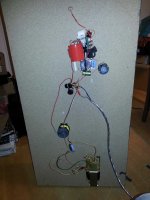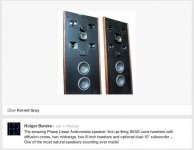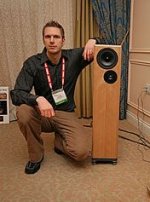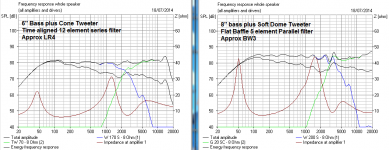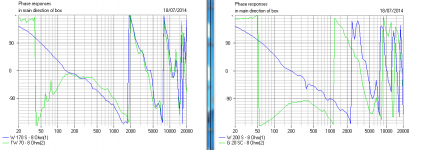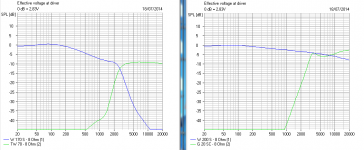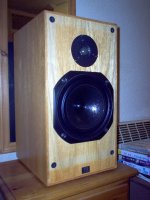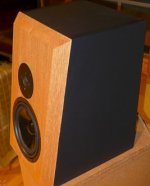The Ohm series are still one of the all-time great speakers. Flawed, of course, like all speakers, with limitations in power-handling, low efficiency, and occasional coloration in the midrange. But against that is a near-textbook-perfect omnidirectional speaker with pretty good impulse response. In a lot of ways, I prefer their relaxed sound to the far more expensive MBL's.
If you could somehow combine them with an ionic tweeter (above 8 kHz, for example), that would be a remarkable speaker.
If you could somehow combine them with an ionic tweeter (above 8 kHz, for example), that would be a remarkable speaker.
Last edited:
This is a german review of the original ones :hifimuseum.de - Sie sind im Bereich : OHM F Test 1974 (de)
The rebuild ones i heard recently had much better efficiency, less coloration and very extended treble.
The rebuild ones i heard recently had much better efficiency, less coloration and very extended treble.
OHMF rebuild?
Hi there J: Do you have any information on the method of "rebuild" for OHM F?
Also, I still have and listen to my Rectilinear lll stereo pair. ...regards, Michael
This is a german review of the original ones :hifimuseum.de - Sie sind im Bereich : OHM F Test 1974 (de) The rebuild ones
i heard recently had much better efficiency, less coloration and very extended treble.
Hi there J: Do you have any information on the method of "rebuild" for OHM F?
Also, I still have and listen to my Rectilinear lll stereo pair. ...regards, Michael
As far as i can tell the Titanium foil is new, so is the voicecoil and the suspension.
Both, the spider and the surround.
I will have a meeting with the rebuilder soon so i may get more information.
It was a real surprise to hear this so well after nearly 40 years.
It works for sure.
Both, the spider and the surround.
I will have a meeting with the rebuilder soon so i may get more information.
It was a real surprise to hear this so well after nearly 40 years.
It works for sure.
There where other speakers of the 70th that image well.
The Beveridge and the original Manger Discus for example.
Quad 57 and the newer ones with the rings where not that bad.
I even owned a Levinson HQD.
By the way i have restored a DUAL CL190, the role model for this design, for a friend of mine as authentic as i could.
As Lynn reported from the american dynamic speakers of the day they sound difuse and opaque. I think too one of the main problems not understood at that time was difraction.
The other thing that is totally off with that speaker is the crossover.
The Beveridge and the original Manger Discus for example.
Quad 57 and the newer ones with the rings where not that bad.
I even owned a Levinson HQD.
By the way i have restored a DUAL CL190, the role model for this design, for a friend of mine as authentic as i could.
As Lynn reported from the american dynamic speakers of the day they sound difuse and opaque. I think too one of the main problems not understood at that time was difraction.
The other thing that is totally off with that speaker is the crossover.
Here are measurements from 1975.
I do not know from what distance and on what axis they measured.
I am quite sure it was done in an anechohic chamber but i do not swear on it.
The response is a bit ragged but ok i think but there is a tilt from the bass to the treble.
The samples i heard sure sounded quite heavy compared to modern standarts.
Not bright as many speakers do today and it was fun if not accurate in any way.
I could also not make the right speaker measure the same then the left speaker so yes, tolerances where higher.
The BBC inspired british speakers where better in the 70th concerning pair matching, that is known.
I do not know from what distance and on what axis they measured.
I am quite sure it was done in an anechohic chamber but i do not swear on it.
The response is a bit ragged but ok i think but there is a tilt from the bass to the treble.
The samples i heard sure sounded quite heavy compared to modern standarts.
Not bright as many speakers do today and it was fun if not accurate in any way.
I could also not make the right speaker measure the same then the left speaker so yes, tolerances where higher.
The BBC inspired british speakers where better in the 70th concerning pair matching, that is known.
Attachments
Now i see it. They measured in 2m in the listening room.
They even mentioned that the bass is too heavy in the CL190.
They even mentioned that the bass is too heavy in the CL190.
There is a peculiar resonance at 160Hz, maybe the room, maybe not.
Reading further into the text reveals that they EQed the 160Hz Peak out and that cleaned up the sound.
That was the time of the Graphic Equalizer and then came Mark Levinson......
Reading further into the text reveals that they EQed the 160Hz Peak out and that cleaned up the sound.
That was the time of the Graphic Equalizer and then came Mark Levinson......
I build and measured the passive version. All looks good.
I put it now in my system.
When i like the result i will post a full schematic.
I put it now in my system.
When i like the result i will post a full schematic.
I have put the speakers now in my system.
I use my tube system at the monent.
I listened to vinyl on my Spriral Groove SG1 with Lyra Atlas.
The phono stage is tube. I designed it. It even does not have an input transformer.
I use selected 6C45Pi at the input and one one pair in 8 that was suprising quiet.
My Power amp is a modified LA Audio from 20years ago.
At the input there is an ECC803S, then ECC802S and a pair of KT120 in triode mode.
I use 60mA idle.
The speaker cable is a big Wire World Platinum Eclipse.
First the sound was a bit overblown but after i had put some BFly dampers under the speakers balance was fine.
I think the bass is in good proportion. My lab measurements do not show this but it is likely that the bass in the listening room is more pronounced then my nearfiled lab measurements show.
I use my tube system at the monent.
I listened to vinyl on my Spriral Groove SG1 with Lyra Atlas.
The phono stage is tube. I designed it. It even does not have an input transformer.
I use selected 6C45Pi at the input and one one pair in 8 that was suprising quiet.
My Power amp is a modified LA Audio from 20years ago.
At the input there is an ECC803S, then ECC802S and a pair of KT120 in triode mode.
I use 60mA idle.
The speaker cable is a big Wire World Platinum Eclipse.
First the sound was a bit overblown but after i had put some BFly dampers under the speakers balance was fine.
I think the bass is in good proportion. My lab measurements do not show this but it is likely that the bass in the listening room is more pronounced then my nearfiled lab measurements show.
Again i was supprised how homogenoius, spacy and well focussed this speakers sound.
Most of my commercial speakers are slim so this came as a supprise.
Of cause i knew that phenomenon from the semi active version.
It seems to be that the passive version is slightly fuller, warmer and less tight then the semi active version. I expected that too. Taking off the grill then restored to a more open and crispy sound. It must not even be the diffenrence in technology that is responsible for this. Tiny diffences in the dB range can be responsible though.
Anyway, i made sure when i did the crossover that the fundamental tones are fully fleshed out.
Love is just a 4 letter word by Joan Baez then really beamed me into the 70th.
There is was : that spaciousness and wamths that many recent high end speakers lack.
OK, this speaker is not as squiky clean then say my Suesskind Tangram that uses much more expensive drivers like the RAAL ribbon and much more elaborate cabinet work plus expensive passivs. In the crossover of the TQGS i used whatever i found in the bin.
Not really bad stuff but nothing fancy. This should be and is a fun project.
Se how it looks.
For what it is worth it is uncloured and wideband, maybe with an extra dose of wamths and that is what i wanted.
It is relaxed listen.
Most of my commercial speakers are slim so this came as a supprise.
Of cause i knew that phenomenon from the semi active version.
It seems to be that the passive version is slightly fuller, warmer and less tight then the semi active version. I expected that too. Taking off the grill then restored to a more open and crispy sound. It must not even be the diffenrence in technology that is responsible for this. Tiny diffences in the dB range can be responsible though.
Anyway, i made sure when i did the crossover that the fundamental tones are fully fleshed out.
Love is just a 4 letter word by Joan Baez then really beamed me into the 70th.
There is was : that spaciousness and wamths that many recent high end speakers lack.
OK, this speaker is not as squiky clean then say my Suesskind Tangram that uses much more expensive drivers like the RAAL ribbon and much more elaborate cabinet work plus expensive passivs. In the crossover of the TQGS i used whatever i found in the bin.
Not really bad stuff but nothing fancy. This should be and is a fun project.
Se how it looks.
For what it is worth it is uncloured and wideband, maybe with an extra dose of wamths and that is what i wanted.
It is relaxed listen.
Attachments
This is another speaker of the 70th with multiple tweeters, this time firing up.
It is the Phase Linear Andromeda.
I am, now 100% happy with the sound of the passive version.
It needed a certain run in time but now the bass is deep and tight.
I plan to bring that speaker to ETF so more can hear it.
It is the Phase Linear Andromeda.
I am, now 100% happy with the sound of the passive version.
It needed a certain run in time but now the bass is deep and tight.
I plan to bring that speaker to ETF so more can hear it.
Attachments
Here is some more information about the Andromeda :Phase Linear Andromeda Speakers
The more a look the more i am amazed what crativity and variaty was there in the 70th.
That is much diffent from now where speakers from the big players are more similar.
That does not say that all was well and good but there was certainly much more internal research going then then looking at the competitiion like nowerdays and make it just a bit better instead of radically different.
The more a look the more i am amazed what crativity and variaty was there in the 70th.
That is much diffent from now where speakers from the big players are more similar.
That does not say that all was well and good but there was certainly much more internal research going then then looking at the competitiion like nowerdays and make it just a bit better instead of radically different.
I think DIY has now taken over the role as a creativity pool. That is one of the reasons i am contributing to the DIY comunity.
It inspires me more then just looking at the commercial things.
It inspires me more then just looking at the commercial things.
Secrets of the ancients...LOL
It's the seventies (aka 70s or 1970s) not the 70th, Joachim! 😉
Very pleased you do help out here. Here's a piece I did some time back:
I'm always impressed by the best old designs. Celestion had Steen Duelund's 4th order 3-way theory almost exactly right. The "British Sound", like KEF, was constant power 18dB/octave BW3 and the BBC tilt in 2-ways really.
SEAS, interestingly, made 12dB/octave LR2 work nicely in a 3-way, though I wouldn't fancy LR2 in a 2-way: SEAS Kit 503
We are very obsessed with parallel 24dB/octave LR4 2-ways these days, but I find series filters the natural stomping ground of odd-order filters and 9dB/octave and 15dB/octave. Why do odd order filters sound so good in two ways? And why does doubling up the mid drivers seem to be such a good thing in three ways? 😕
It's the seventies (aka 70s or 1970s) not the 70th, Joachim! 😉
Very pleased you do help out here. Here's a piece I did some time back:
I thought I'd elaborate on why the top sixties HiFi was better than most junk you buy today. But this is not for discussion. I will simply state 6 good reasons, and you can stuff them in your pipe and smoke them. 😀
1) Engineers were older, had lived through WW2 and had a much broader background in Radio and antennas and high frequencies and would even make their own components like coils and oiled paper capacitors. They had far better mental arithmetic ability than most of you, and could use a Smith chart for matching impedance and a slide rule for calculation much faster than you can with computers:
An externally hosted image should be here but it was not working when we last tested it.
An externally hosted image should be here but it was not working when we last tested it.
2) I have no particular axe to grind on transistors versus valves, and in fact classic performers like the Radford STA25 had a single rail transistor preamplifier driving a valve output stage with a defined source impedance. But they were Class A designs with all the lovely cancellation of common-mode that makes them sound so good. The power supply for instance had only to drive a constant current and all electrolytic capacitors had the proper bias which keeps them linear.
3) Record pickups were wide bandwidth and low source inductance moving coil designs. These avoided trying to jump out of the groove due to LC resonances which plagued later moving magnet designs and LP crackle and pop was less obtrusive.
4) Bass speakers would often be 10" paper cones in huge solid closed boxes mounted literally as bookshelves against a wall. Tweeters would often be simple 3" paper cones with a single capacitor crossover. It didn't much matter how good the speaker surround was, because acoustic suspension essentially kept the speaker linear. Frequency response was probably not the last word, but rolled off gently. In fact the reputable WLM La Scala speakers rather recreate these babies.
5) Components like transistors were doubtless not as fast, but then feedback was kept much lower too, so gross distortions like slewing tended to be avoided in favour of gentle rolloff of frequency response.
6) Recording engineers really knew their equipment like the backs of their hands. They set up levels to avoid overload and at their peak would record straight to the record-cutting lathe via a mere couple of microphones with no recording console worth mentioning. The result was breathtakingly direct recordings like Count Basie with Frank Sinatra, which if you've never heard them on Vinyl with it's 70dB signal to noise ratio, well you haven't lived, my friends! 😀
An externally hosted image should be here but it was not working when we last tested it.
Onwards and upwards! 😉
I'm always impressed by the best old designs. Celestion had Steen Duelund's 4th order 3-way theory almost exactly right. The "British Sound", like KEF, was constant power 18dB/octave BW3 and the BBC tilt in 2-ways really.
SEAS, interestingly, made 12dB/octave LR2 work nicely in a 3-way, though I wouldn't fancy LR2 in a 2-way: SEAS Kit 503
We are very obsessed with parallel 24dB/octave LR4 2-ways these days, but I find series filters the natural stomping ground of odd-order filters and 9dB/octave and 15dB/octave. Why do odd order filters sound so good in two ways? And why does doubling up the mid drivers seem to be such a good thing in three ways? 😕
I am not a fan of series filters, sorry.
Problem is that a shelf in the tweeter response ( in a two way ) screws up the phase response.
At Sonics i made a very successful 2 way, the Argenta.
It had 5 elements in the crossover and measured very flat, also off axis.
I then made a resies filter THAT HAD THE EXACT PHASE AND FREQUENCY RESPONSE and ended up with 11 passive components i think.
Do not compare apple and oranges.
With magnetostatic tweeters it may work. Raidho does and they sound good.
Problem is that a shelf in the tweeter response ( in a two way ) screws up the phase response.
At Sonics i made a very successful 2 way, the Argenta.
It had 5 elements in the crossover and measured very flat, also off axis.
I then made a resies filter THAT HAD THE EXACT PHASE AND FREQUENCY RESPONSE and ended up with 11 passive components i think.
Do not compare apple and oranges.
With magnetostatic tweeters it may work. Raidho does and they sound good.
Last edited:
Why does a speaker like the one i present here sound good ?
First the closed box woofer. It is more tight and clean then a reflex.
Having it close to the floor gives 6dB gain so the theoretical advantage of a reflex to have some more output capability in the upper bass does not look so atractive any more when the woofer is further away from the floor.
The two 13cm midranges have the same area then say one 18cm midrange but have a much better relation from moving mass to magnet strength so they are faster.
The smaler membran is stiffer and breaks up higher.
The two tweeters alow a lower crossover from the bigger tweeter to the midranges.
That gives a better off axis response and where the ear is most sensitive, say from 1.5Khz to 5kHz the mooving mass is only 0.4 Gramms.
Even a very light coned 17cm crossed at 4kHz in the midrange like the english do ( not always ) has 10 Gramms minimum.
That is 25 times less giving tremedoes resolution and dispersion-
The double tweeters give less doppler and intermodulation distortion so does the 4 way contruction over the whole range.
The challenge then is to make a crossover that blends well.
First the closed box woofer. It is more tight and clean then a reflex.
Having it close to the floor gives 6dB gain so the theoretical advantage of a reflex to have some more output capability in the upper bass does not look so atractive any more when the woofer is further away from the floor.
The two 13cm midranges have the same area then say one 18cm midrange but have a much better relation from moving mass to magnet strength so they are faster.
The smaler membran is stiffer and breaks up higher.
The two tweeters alow a lower crossover from the bigger tweeter to the midranges.
That gives a better off axis response and where the ear is most sensitive, say from 1.5Khz to 5kHz the mooving mass is only 0.4 Gramms.
Even a very light coned 17cm crossed at 4kHz in the midrange like the english do ( not always ) has 10 Gramms minimum.
That is 25 times less giving tremedoes resolution and dispersion-
The double tweeters give less doppler and intermodulation distortion so does the 4 way contruction over the whole range.
The challenge then is to make a crossover that blends well.
Last edited:
Ah, well, if I had to guess, you crossed the 6" SEAS driven Sonics Argenta over rather low, maybe 2.2kHz on second order filters. But that's horrible, because it won't go loud without tweeter distortion. I hate 6" paper bass. Too much cone breakup low. 😡
What do you think of John Devore's idea (pictured below) of inverting the tweeter below the woofer on what I assume is BW3? Regular speakers always sound better below axis, IMO.
He is one of your fans, BTW. You knew that. 😀
I think the best English speaker ever was the Wharfedale E70:
English BBC polycones are kinda unexciting IMO, and we shouldn't think that anyone except the splendid Harbeth and Spendor even takes them too seriously any more. But I like the BW3 stuff, just like in your time aligned Anima speaker, which deserves a picture for folks who don't know it:
Lovely. I was inspired by that design. And I think you're onto something with doubled mids here. 🙂
What do you think of John Devore's idea (pictured below) of inverting the tweeter below the woofer on what I assume is BW3? Regular speakers always sound better below axis, IMO.
He is one of your fans, BTW. You knew that. 😀
AV Enthusiast - Interview: John DeVore of DeVore FidelityAVE: Are there any designers that you particularly admire or whose work inspired you when you decided to start designing loudspeakers?
JD: Absolutely. Having been in the industry for a couple of decades I’ve accumulated a pretty long list of designers I admire for various reasons, here’s a very incomplete list: John Bau, Joachim Gerhard, James Lansing, Ed Meitner, Nelson Pass, Franco Serblin, Peter Snell, Bruce Thigpen, and Peter Walker.
I think the best English speaker ever was the Wharfedale E70:
An externally hosted image should be here but it was not working when we last tested it.
English BBC polycones are kinda unexciting IMO, and we shouldn't think that anyone except the splendid Harbeth and Spendor even takes them too seriously any more. But I like the BW3 stuff, just like in your time aligned Anima speaker, which deserves a picture for folks who don't know it:
An externally hosted image should be here but it was not working when we last tested it.
Lovely. I was inspired by that design. And I think you're onto something with doubled mids here. 🙂
Attachments
You are quite outspoken and you never heard that speaker.
Sold hundreds and got a phenomenal test in Audio.
I think acoustical it was 4th order, anyway.
John, he is a nice chap.
Sold many Virgos in the 90th at Sound by Singer.
Who inspired whom, say no more.
I moved on.
Sold hundreds and got a phenomenal test in Audio.
I think acoustical it was 4th order, anyway.
John, he is a nice chap.
Sold many Virgos in the 90th at Sound by Singer.
Who inspired whom, say no more.
I moved on.
Joachim, as Frazier said, "I don't correct people's grammar to make myself popular", but it's the 90's not the 90th! 😀You are quite outspoken and you never heard that speaker.
Sold hundreds and got a phenomenal test in Audio.
I think acoustical it was 4th order, anyway.
John, he is a nice chap.
Sold many Virgos in the 90th at Sound by Singer.
Who inspired whom, say no more.
I moved on.
A guy like you doesn't make bad speakers, though I think your ceramic tiles on one model might have been "an interesting failure." Your Argenta doubtless works because you are using very good and well-behaved quality drive units as usual. But admit it, cost aside, you could do a better LR4 speaker with more components, perhaps a newish SEAS U18RNX/P and one of your sloped boxes! 😛
The time aligned LR4 target response is quite simple:
An externally hosted image should be here but it was not working when we last tested it.
And Steen Duelund laid down the typical time aligned 3 way LR4 response for all time, IMO:
An externally hosted image should be here but it was not working when we last tested it.
But LR4 is just one of the filter theories, there is BW3 and LR2 as well. Then there are pistonic dispersion metal drivers, and gaussian dispersion plastic ones. And stuff in between like ring radiators, which all seems interrelated since they are mechanical filters and apertures. I'm sure Prof. Leonard Susskind could sort it all out PDQ for us if he joined Diyaudio.
An externally hosted image should be here but it was not working when we last tested it.
But endlessly fascinating. Which is why we do it. Looking forward to seeing the filter here. 🙂
To give something back, below is some modelling of a series filter which I haven't built yet, and a parallel filter which I have. The parallel filter owes a lot to your ideas, and it sounds sweet! Isn't it weird how the dip in impedance corresponds to the crossover point with both designs? 😎
Attachments
- Status
- Not open for further replies.
- Home
- Loudspeakers
- Multi-Way
- The Quintessentially German Loudspeaker of the 70th. Modern Interpretation.

